Why is Starbucks' biggest competitor an "empty" bakery?
Professional barista communication, please pay attention to coffee workshop (Weixin Official Accounts cafe_style )
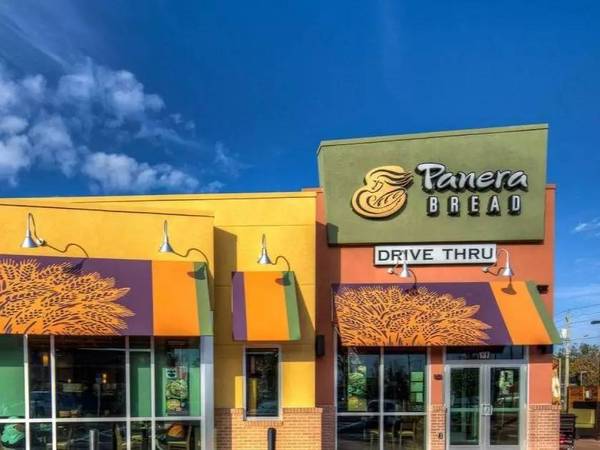
author| He Shan Editor| dongqing
Tiger Sniff Note: This article was first published from Weixin Official Accounts Shopkeeper Strategy (ID: zggonglue), Tiger Sniff authorized to reprint.
At $7.5 billion, that's the second-largest restaurant merger in North America in recent decades.
Who's worth all that money?
Panera Bread, a bakery and light eatery.
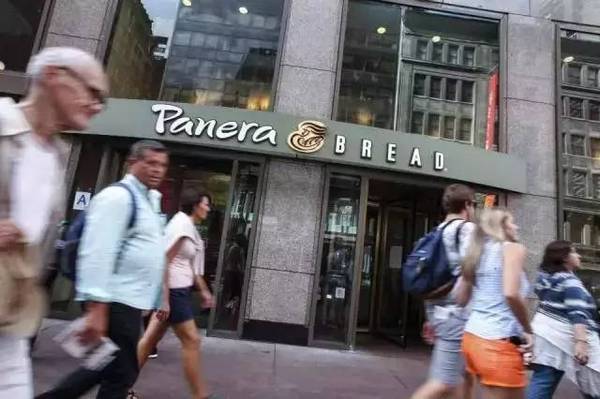
Panera Bread
Panera Bread, founded exactly 30 years ago, focuses on home-baked products and simple meals such as salads, sandwiches and soups. It now has more than 2000 stores in the U.S. and Canada, about half owned and half franchised, and annual sales of $5 billion.
It was bought by JAB Capital from Luxembourg, which has swept through many restaurants in recent years and has a plan called Coffee and Bagels. Among the acquisitions already under the program are doughnut giant Krispy Kreme, home-coffee maker upstart Keurig Green Mountain, Jacobs Douwe Egberts, which owns both coffee production and coffee shop businesses, and well-known boutique coffee brands Stumpton and Intelligentsia.
The investment community believes that Panera Bread, which has recently fallen into the bag, is likely to feel the coffee aroma in the big family next, complementing the short board of the drink, and the key target of this "brand integration store" is Starbucks.
Panera Bread hasn't entered China yet. Let me show you what the store looks like first.
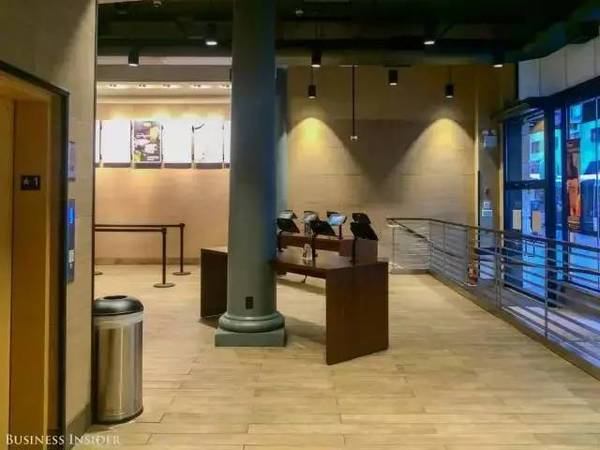
Business doesn't look good. So why covet starbucks?
This sounds like a man-made person or a code name for landing Jupiter, but it is actually a brand upgrade plan that has been brewing internally since 2012 and officially announced in April 2014. Its core goal is to enhance the consumer experience through operational optimization and technology. And the changes that consumers feel most directly are: digital ordering and line-skipping experiences.
That's why the shop in the picture at the front door is empty. This process, which is implemented through mobile apps, web pages and tablets in stores, can be roughly divided into two steps:
The first step, and the most important step, is the tablet in the store. At the beginning of the plan, at least seven units have been installed in each store on average, occupying separate tables and areas where consumers can choose dishes directly, complete payments, and take a sensor to sit. The tracking system behind the sensor will let the waiter deliver the dish to the correct table. You don't have to go over there and pick yourself up with that crazy vibrating, flashing sensor.

Plates appearing in groups and their exclusive areas
The second step is the web page on PC and the app on mobile. Their core service is Rapid Pickup service. not
Empty diners can order in advance and pick up their meals later (but the tablets in the store also have buttons to let you use the service). There is a special dining area in the store, a large screen on the wall to show the preparation of the order; there are also shelves, if you come late, you will also see your meal waiting for you; some stores have seats in the dining area, early or too many people are not afraid, we sit and wait.
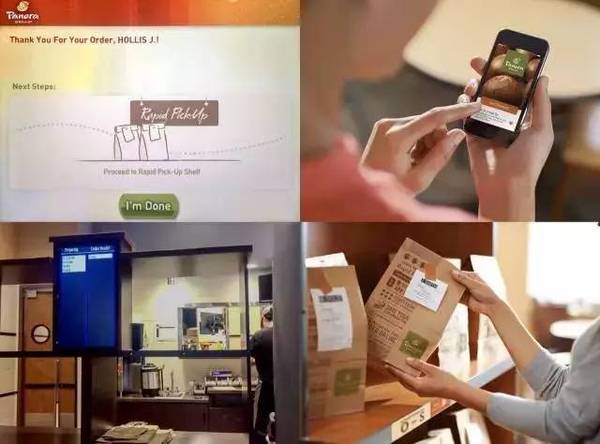
Rapid Pickup can be selected whether you use your tablet (top left) or mobile phone (top right). Real-time tracking of progress in the store (bottom left), as well as clean and convenient shelves for placing orders (bottom right)
Panera 2.0 has cost $120 million so far, but it works so well that you forget the cost:
Panera Bread's annual profit grew 6% in 2015 and 9% in 2016.
Panera 2.0 has accelerated to 70% of self-owned stores, more than 25% of sales have come from digital orders (up to 35% in individual mature stores), and same-store growth was still recorded as high as 6.2% in the first quarter of this year. The current installation rate and growth rate of franchised stores are not satisfactory, which is also Panera Bread's primary goal for 2017.
Another important business, outsourcing, has also benefited, with more than half of orders now placed online and quarterly growth rates of 10% or more.
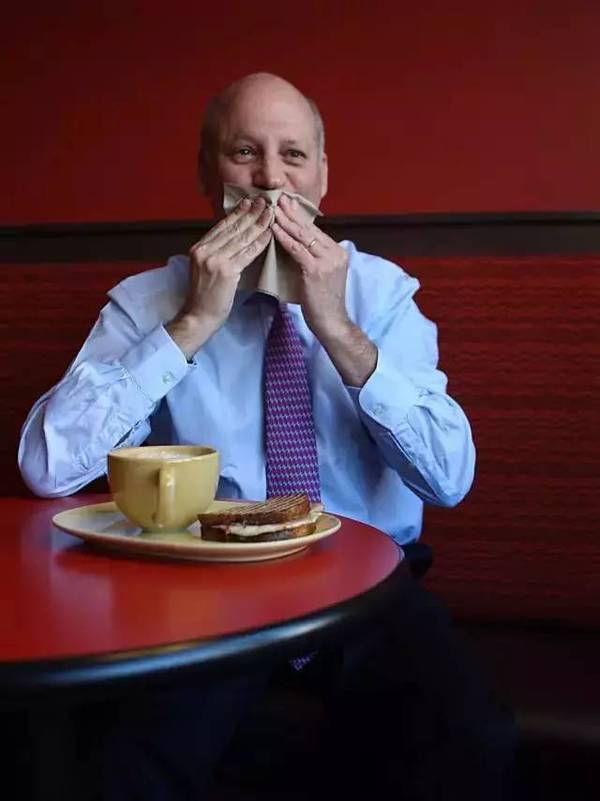
Boss Ron Shaich is happy.
1
The effect is good because the right medicine is given early enough.
Panera Bread's two main features allow them to focus on the touch-screen menu represented by the in-store tablet. If your store also fits these two characteristics, just as the iPad has just launched a new model, you can buy a little bit of the old model that is on sale.
1. Multiple categories, complex menu structure
On the left side of the ordering page, you can find the menu category of this fast casual brand (blue box below), which is really old and young, comparable to dinner restaurant: large dishes, pasta, salad, soup and other bowl snacks, sandwiches, scones, children's meals, drinks, baked products (such as large bread, scones, etc.), side dishes and sauces. You now understand why the average order time of this brand was 8 minutes. If you are not a frequent visitor, 8 minutes is enough to read through the menu. It is estimated that it can be pasted on a large wall in the store. Now, the order time is compressed to 1 minute. Touch screen ordering saves time and effort, and makes the store look cleaner and simpler.
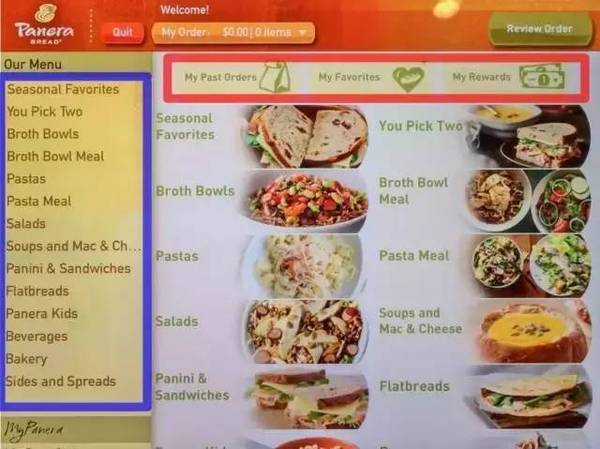
Order page on tablet
2. Push the membership mechanism
In a prominent position on the screen (red box above), you can quickly check your past orders, stored regular food, and membership points. Panera Bread launched its own membership program MyPanera back in 2010 and now has 25 million users. Its most important feature, and also the most advantageous play method, is that "you don't know when to give you a discount", which day you swipe your card and send you a salad. This kind of surprise benefit makes it most convenient for customers to inquire on the screen every time.
3. The product itself has a large amount of information
Panera Bread is regarded as the first American chain enterprise to make public its "list of prohibited ingredients", which includes artificial colors, flavors, sweeteners and preservatives. They promise to complete this big clean-up by 2016, which is why Panera Bread's core consumer group is young and middle-aged women with above-average income, who are especially concerned about calories and nutritional balance. Touch screen ordering allows the nutritional information and ingredient list of each dish to be the richest and most intuitive embodiment.
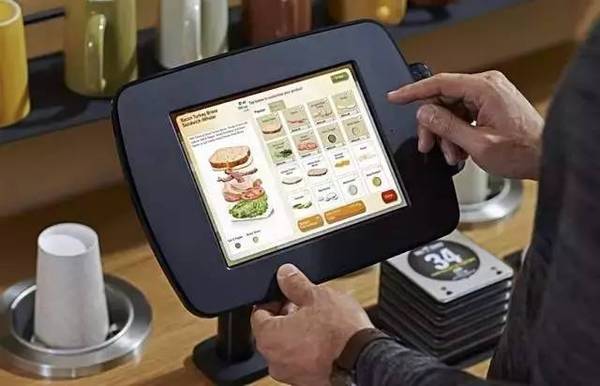
Even if it's a sandwich, it can be taken apart and customized one by one.
2
Digital upgrades are not as simple as finding an outsourcing team and buying tablets.
Panera Bread demonstrates what it means to be well-prepared when digital ordering has become a favorite of many giants such as Taco Bell and Starbucks.
First of all, don't take chances, thinking that with machines and systems, you can ask less employees to pay less. Money is earned, not saved.
At the beginning of the promotion period, the store specially set up a "ordering table ambassador", especially when busy they can help customers quickly order checkout, at the same time timely troubleshooting all kinds of system failures, prevent queuing in front of the screen; at the same time, also clean the tablet in time to keep the touch screen clean. So sometimes, moving into a digital storefront doesn't necessarily mean a sharp drop in labor costs.
The front office staff, in addition to some to be "ambassadors," there are many to provide desk service, after all, we mentioned earlier, table delivery is an important part of this experience upgrade revolution.
Some people at the counter went to the front hall, and some people went to the back kitchen. In addition to store food, the kitchen is now facing a large number of Internet orders, and because of the high customization brought by the screen, orders are bound to be more diverse, how to ensure efficiency and accuracy is the key to production, so more people are needed to participate in production. Before the food is delivered to the customer, there are quality inspection employees who hold the final pass to confirm that the product is accurate and of good quality.
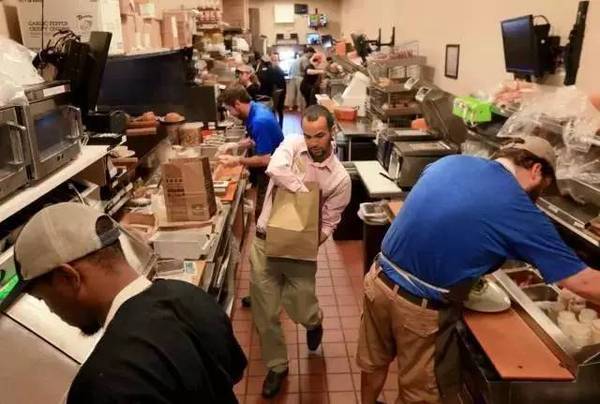
There are more tablets, and there are no fewer people.
Second, the visible places are installed, invisible places do you remember to upgrade together?
To prepare employees for the new changes, Panera Bread has redeveloped a complete training curriculum system.
The Kitchen Display System allows customers to see their special needs more clearly. If there are any changes to the order, press the "Mod Tag" button to confirm that the changes have been found and completed, which can improve the accuracy of the production.
Automatic workload balancing system, according to the busy situation of each segment of the current production line, arrange the task allocation of new orders.
New wiring center. Users who do not use tablets, mobile phones or computers can also place orders by phone and enjoy the convenience of fast access to meals. By the way, you might still see a checkout counter in Panera Bread stores today, after all, respecting customers who don't want to use digital orders.
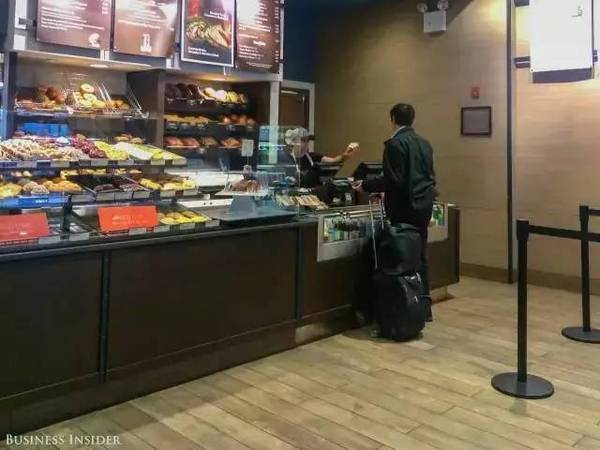
In case your mobile phone runs out of battery and you hate using tablets, there are still tellers to serve you.
The most important thing is to adjust the production line to make the product faster. Panera Bread now takes 35 seconds to make a sandwich, while Panera 2.0 aims to reduce the processing speed of each dish to less than three minutes, which means that customers don't want to wait. So here we can transition to the next point:
In the end, both the system and the customer are "tuned" properly, but can you stand it when they both start ordering on their phones/screens?
This lesson is what happened to Starbucks, Sweetgreen and other digital revolution red fried chickens, and it is also the thinking of overseas media about the bottleneck period of digital order.
Starbucks launched its in-app payment system in 2011, harvesting 26 million transactions in its first year of operation, and last year its mobile payments were heavily used once launched, now accounting for 7% of total transactions. Although this number is only
Panera Bread is less than a third of the way, but earlier this year, Starbucks stores in the United States had a lot of customers with cell phones.
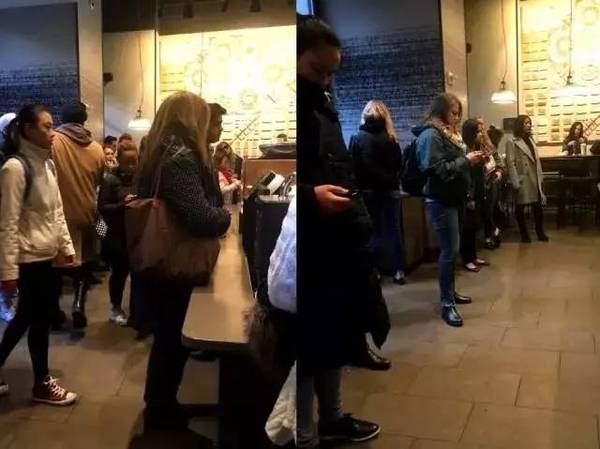
I was careless. I had to queue up again if I couldn't order in advance.
The embrace of new technology came too strongly, the habit of using it was cultivated too quickly, and the number of online orders surged, so that the clerk had to deal with the store customers and the continuous online orders. In the end, it was too late, so everyone ended up waiting together in the store, so what was the point of pre-ordering and paying in advance?
When the company had no time to respond, the employees could only spontaneously carry out various remedies in the store, so there was such a human tragedy as the following picture.
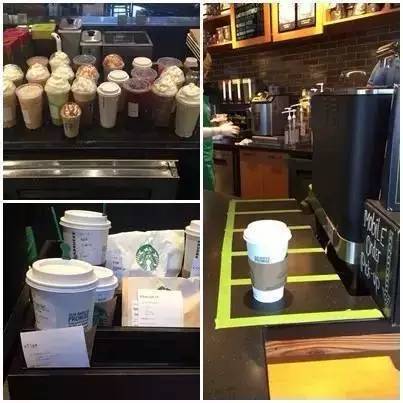
The loss outweighs the gain and seriously affects the experience. As a result, customers are lost. Starbucks admitted that customers saw this form of queuing and turned away; at the beginning of this year, Starbucks reported a 2% drop in transaction volume in the most recent quarter, largely due to heavy Internet order congestion, which is directly related to store revenue and same-store growth rates.
Also at the beginning of this year, a group of fast leisure and fast food enterprises encountered difficulties. Shake, which launched Shack App in December last year,
Shack stores experienced significant system lag during rush hours; Sweetgreen stores in New York, which aggressively promoted cashless restaurants, were forced to send emails to customers telling them that all reservations would be delayed by about 15 minutes. The average wait time of 20-30 minutes allowed Chipotle customers to fire up online and forced the company to invest in new systems in March to meet online orders.
Dig too many canals, but not enough big pond, so finally issued a flood, can only blame themselves.
So that's why when Panera 2.0 started, new stores needed to preset tablet use areas and quick take-out areas, and old stores tried to readjust the internal area structure. The upgrades to the kitchen and service we mentioned in the previous point are precisely to raise the store efficiency to the next level and avoid the above situation.
New backer, new future
Panera Bread, which joins the new family, is about to embark on the next huge plan. By the end of this year, they will have added tens of thousands of people.
His own delivery team began to deliver a large number of takeaways.

Panera Bread Team Ready to Go
Panera Bread has been delivering takeaways since early 2015, contributing about $5000 (about 10%) a week to store sales. By the end of the year, they hope to boost takeout revenue to 40% of the total.
The brand sees a gap in the takeaway market: pizza or Chinese food, so they want to get in with a healthier, more diverse approach. And they don't use mercenaries, which means they don't work with third-party platforms, which is why the increase is so huge, and 75% of them will be drivers (with their cars), and the rest will be mainly catering positions.
Panera Bread delivers food between 11:00 and 20:00 every day, seven days a week, for as little as $5, shipping costs $3, and covers the area around the restaurant, which is about an 8-minute drive.
What about users? They are becoming more familiar with the mobile and PC side of the operation, as long as the nest in the chair, enjoy the convenience of Panera 2.0, finger poke a few times can "sit and reap the benefits".
Important Notice :
前街咖啡 FrontStreet Coffee has moved to new addredd:
FrontStreet Coffee Address: 315,Donghua East Road,GuangZhou
Tel:020 38364473
- Prev

Want to put the roaster in your own cafe? These 30 review methods are worthy of your discussion.
Professional baristas exchange please pay attention to the coffee workshop (Wechat official account cafe_style) Shanghai Food and Drug Administration on soliciting the "Shanghai roasted Coffee Open production license examination rules (draft)" (June 9, 2017) Comprehensive Coffee experience House is a new type of industry that integrates coffee roasting production display and coffee catering service. For
- Next
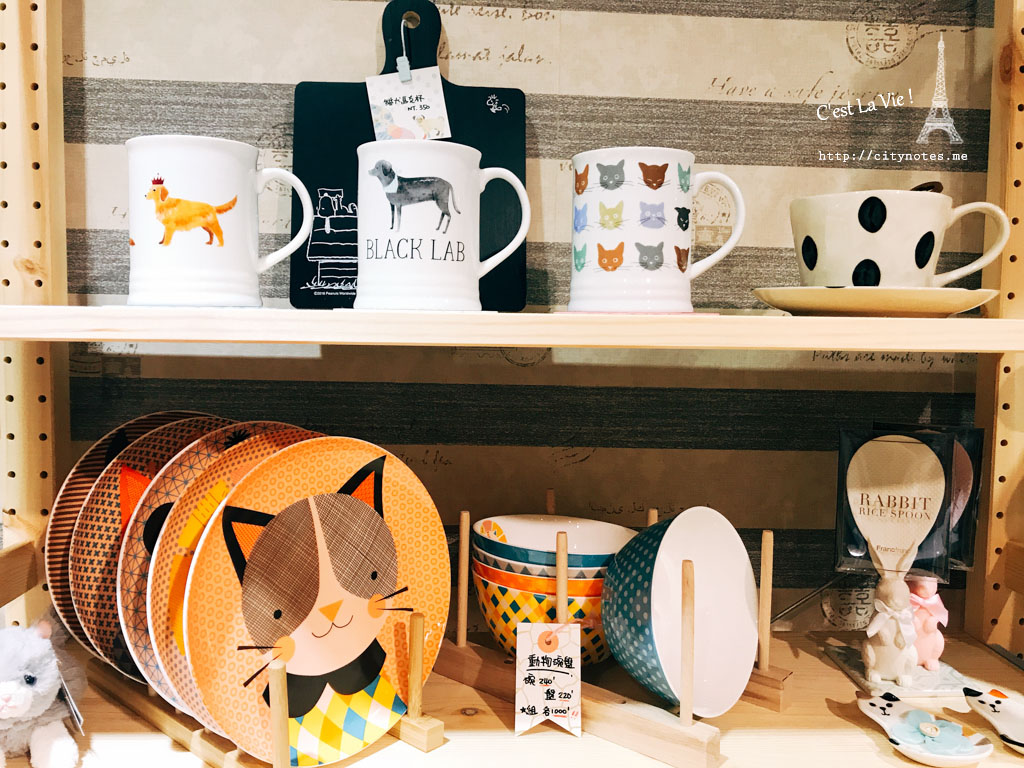
Taipei Coffee Cafe Farfalle Fa Lei Coffee is a good place to talk.
Professional barista communication Please pay attention to the coffee workshop (Wechat official account cafe_style) it rained twice after noon to evening. None of me was spared. I walked awkwardly into Farfalle Farley coffee, which was still in trial operation, like a rabbit escaping into the grass. For a long time, the panic could not be calmed down. The world outside the window crumbled like the beginning of a science fiction movie, but I hid in a room that looked like a romantic movie.
Related
- What documents do you need to go through to open a coffee shop? coffee shop coffee shop certificate processing process
- How to purchase Coffee beans in small Cafe how to choose a suitable supplier for domestic Coffee supply Company
- How to drink Starbucks Fragrance White Coffee? how to make Australian White Coffee? what Italian coffee beans are recommended?
- The Story of Flora Coffee: the name of Flora Coffee Bean and the implication of the Flowers on Florna Coffee
- How much does a cup of coffee cost? How much is the profit of a cup of coffee? What is the profit of the coffee shop in a year?
- Yunnan small Coffee, known as "fragrant Coffee", introduces the characteristics of Alpine Arabica Coffee producing areas in Yunnan, China
- 2023 latest Starbucks full menu price list how much is a cup of Starbucks coffee what is better to drink the most popular hot and cold drinks recommended
- Starbucks different kinds of Coffee Price list Starbucks menu 2023 Top Ten Best drinks in Starbucks
- Starbucks Spring praise Comprehensive matching Coffee Bean theme Story Packaging implication and taste description
- The cost of a cup of coffee latte American coffee cost price and selling price

